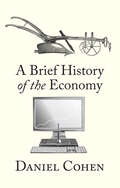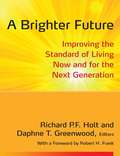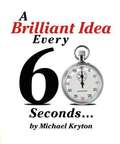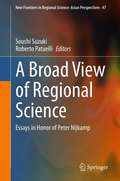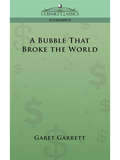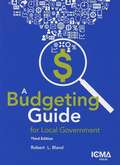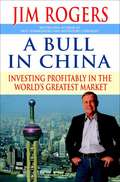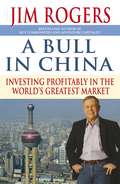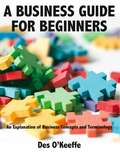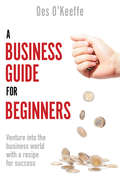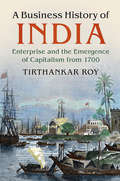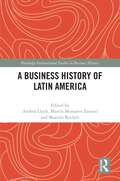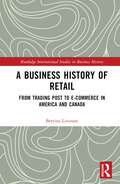- Table View
- List View
A Brief History of the Economy
by Daniel CohenEconomic growth is the religion of the modern world. It promises a solution to the most basic drama of our human existence: wanting what we don’t have. But we live in a time when the frenzied pursuit of economic growth is jeopardizing the planet’s viability and our very survival as a species. How did we get to this point in human history? How did we allow the pursuit of growth to become the apotheosis of human development?To answer these questions, the distinguished economist Daniel Cohen takes us on a journey to understand human desire and the different registers on which it has expressed itself throughout history. He brings his panoramic grasp of the subject to bear on the key stages of social and economic development, from the Neolithic revolution to the digital age. The ideas of the great economists – from Adam Smith and Karl Marx to Joseph Schumpeter and John Maynard Keynes – are situated in their historical contexts and explained clearly and concisely. The result is a triumph of ambition and brevity: a history of the economy in 100 pages.This book – the final work written by Daniel Cohen – will appeal to anyone interested in the economy and in the tension between a limited world and unlimited desires that lies at the heart of the great challenges we face today.
A Brief Note on Global Antitrust
by David B. Yoffie Eric Baldwin Dennis YaoThis brief note explores the critical issues in modern anti-trust policy.
A Brief Overview of China’s ETS Pilots: Deconstruction And Assessment Of Guangdong's Greenhouse Gas Emission Trading Mechanism
by Daiqing Zhao Wenjun Wang Zhigang LuoThis book systematically introduces readers to the framework of China’s ETS pilots, exploring their design and operating process, the current state of the carbon market, and various barriers encountered. To do so, it deconstructs the Guangdong ETS, which is the largest and most representative of China’s seven ETS pilots. The book subsequently describes and evaluates all seven pilots in terms of their efficiency, macro and micro effects, the method involved in the DEA model, the CGE model, and cost-benefit analysis. In turn, in the assessment section it demonstrates how some ETS pilots have failed to control carbon emissions due to inordinately high emissions quotas issued by the local government etc. Further, it argues that ETS should focus on those industries with large emissions and high mitigating potential for the time being, and then gradually expand the scale of its coverage.As China’s national ETS is slated for launch on the basis of the lessons learned from the ETS pilots, the book offers a timely and valuable resource for all those who want to understand and forecast the development of China’s ETS. It includes a wealth of descriptions and explanations of Chinese government policies involving carbon emissions control, making it a unique resource.
A Brief Prehistory of the Theory of the Firm (Routledge Studies in the History of Economics)
by Paul WalkerThe theory of the firm did not exist, in any serious manner, until around 1970. Only then did the current theory of the firm literature begin to emerge, based largely upon the work of Ronald Coase and to a lesser degree Frank Knight. It was work by Armen Alchian, Robert Crawford, Harold Demsetz, Michael Jensen, Benjamin Klein, William Meckling and Oliver Williamson, among others, that drove the upswing in interest in the firm among mainstream economists. This accessible book provides a valuable overview of the ‘prehistory’ of the firm. Spanning an impressive timeline, it delves into Antiquity, the Medieval era, the pre-classical economics period and the 19th and 20th centuries. Next, the book traces the theoretical contributions from pre-classical, classical and neoclassical economics. It will be illuminating reading for students and researchers of the history of economic thought, industrial organization, microeconomic theory and business history.
A Brighter Future: Improving the Standard of Living Now and for the Next Generation
by Richard P. Holt Daphne GreenwoodAs the United States continues its slow climb out of the Great Recession, it is important to focus on new directions to improve the standard of living in America. This book explores what is behind a faltering standard of living in the United States since the early 1980s and what can be done to restore it. The book is uniquely valuable in going beyond mainstream thinking about how to restore prosperity. Economics has traditionally equated economic growth (increases in per capita income) with improvements in quality of life and the standard of living. This book questions that assumption. The different chapters in the book show the standard of living as being more than income, to include many non-market aspects such as access to public goods (roads, clean air and water, schools, parks, and museums), intangible aspects of quality of life such as equity and a sense of community, and broadly based economic opportunities. This means that improving the standard of living is a multi-dimensional challenge rather than one of solely increasing aggregate demand, productivity, or GDP. This book embodies a pluralistic approach and draws on the expertise of a wide array of thinkers. The intended audience is for various courses offered in economics, sociology, political science, public policy programs, and in environmental and ecological studies.
A Brilliant Idea Every 60 Seconds: Unlock Your Ideas and Creativity
by Michael KrytonA Brilliant Idea Every 60 Seconds introduces a tested ideation and creative thinking methodology developed over the author's 36-year career as a creative communications professional and ideation expert. This methodology and the associated tools are being applied in personal lives and professional careers, helping people connect to their individual ways of operating creatively. This how-to book on ideation focuses an individual's creative lens and makes the process of generating ideas highly tangible. It is not simply about techniques; it is also about understanding a context of personal, individual creativity that allows individuals to more fully understand and embrace the Brilliant ideation techniques. Most importantly it is about speed: generating ideas - right now! The book is comprised of three components: Examining individual creativity: understanding the nature of your individual creative process; exploring how you think and operate creatively; understanding how others think and operate creatively; and maximizing the way groups, teams, and think tanks work together creatively and reach their creative potential.The ideation toolkit: understanding the nine inherent values (idea triggers) and how they work to generate idea strings and actionable ideas and the matrix of these inherent values, which makes the creative process and ideation tangible. Case studies: examining over 30 case studies ranging from advertising campaigns and live events to problem-solving situations and innovative product development.
A Broad View of Regional Science: Essays in Honor of Peter Nijkamp (New Frontiers in Regional Science: Asian Perspectives #47)
by Roberto Patuelli Soushi SuzukiThis book celebrates the life and work of Peter Nijkamp, whose research provides a strong focus on regional science. His work follows a rigorous, comprehensive approach, centred around analytical modelling and methodological innovation. This edited volume, like Prof Nijkamp’s research, covers a wide range of topics in regional science, analysed through multi-criteria evaluation, evaluation modelling, econometrics, and simulations, among other methods. These tools are applied to the analysis of society and culture, tourism and information, cities, environment and sustainability. Professor Nijkamp is one of the founders and the past president of the Regional Science Association International. His work forms a valuable reference for researchers, scholars, policymakers, and students in the field of regional science and other disciplines. This volume, timed to coincide with his 75th birthday, celebrates Prof Nijkamp’s great contributions to regional science. He also promoted and participated in the education and development of young researchers not only in regional science but also in other fields, supervising many Ph.D. students and hosting even more as guests in Amsterdam. Contributors to this volume include Prof Nijkamp’s former doctoral students and guest researchers, as well as associates and colleagues.
A Bubble That Broke the World
by Garet GarrettThe burden of Europe's private debt to this country is now greater than the burden of her war debt; and the war debt, with arrears of interest, is greater than it was the day the peace was signed. And it is not Europe alone. Debt was the economic terror of the world when the war ended. How to pay it was the colossal problem. -from "Cosmology of the Bubble" The names of the players are different, but these cautionary essays about massive national debt-written in the long wake of World War I and as the Great Depression was starting to make its horrible power fully known-are still fully applicable today. A powerful libertarian voice of the early 20th century, Garet Garrett, writing originally in the Saturday Evening Post, warned about the extension of American credit to a Europe staggering under a massive debt leftover from the financing of World War I... a situation echoed, if reversed, today as the overextended United States continues her rampant borrowing. Collected in book form, Garrett's writings are a cry for a retreat from financial insanity, a clear-eyed look at a complicated and little understood era of financial history, and perhaps an ominous warning for today.
A Budgeting Guide for Local Government
by Robert L. BlandThis third edition provides a contemporary and strategic perspective on budgeting as it has evolved from an accounting function to a tool for introducing new management strategies and practices to local government.
A Building Information Modelling Maturity Model for Developing Countries (Routledge Research Collections for Construction in Developing Countries)
by Clinton Ohis Aigbavboa Wellington Didibhuku Thwala Abdul-Majeed Mahamadu Samuel Adekunle Obuks EjohwomuThis book provides a reference point for the development of Building Information Modelling (BIM) maturity in the developing country context. Developing countries have been observed to have low BIM maturity and are struggling to adopt the technology amidst no clearly defined pathways for achieving BIM capability maturity. The research presented in this book provides construction industry stakeholders in developing countries with a framework and nomological map to aid in the advancement of BIM implementation. This work provides a pathway for overcoming the challenges inhibiting BIM maturity in developing countries and ultimately its diffusion in order to harness the benefits. The authors provide critical theoretical insights on BIM maturity in the developing country context, a comparative analysis of BIM maturity in both developing and developed countries, and finally, a conceptualisation of BIM maturity for developing countries. The book is unique as its construct is rooted in the state-of-the-art information management standards in the digitalisation era in the construction industry (ISO 19650). The book delivers a theoretical reference point to the academic and research community and for the industry stakeholder, an essential guide to achieving BIM maturity at macro and micro levels.
A Bull in China: Investing Profitably in the World's Greatest Market
by Jim RogersIf the twentieth century was the American century, then the twenty-first century belongs to China. Now the one and only Jim Rogers shows how any investor can get in on the ground floor of "the greatest economic boom since Englandâ ²s Industrial Revolution. " In this indispensable new book, one of the worldâ ²s most successful investors, Jim Rogers, brings his unerring investment acumen to bear on this huge and unruly land now being opened to the world and exploding in potential. Rogers didnâ ²t just...
A Bull in China: Investing Profitably in the World's Greatest Market
by Jim RogersProfiting from China without getting burned is currently an obsession with the international investment community. The estimated size of the Chinese economy has just been revised upwards, making it the 4th largest in the world behind the US, Japan and Germany, and ahead of the UK but the idea that investing in China is a sure-fire, get-rich-quick investment story is dangerously misleading. * The author of the bestselling Investment Biker, Adventure Capitalist, and Hot Commodities, is providing a book that provides a window into what will soon be the most vital, most lucrative market of our time: China. * While the Chinese economy has had an annual average growth of 9.4 percent since 1978, and despite the ongoing speculation about China's future, its stock market is now emerging from a six-year low. * As the Chinese economy continues to lumber toward a free market system - and as the Chinese government inevitably unpegs its currency and opens its stock market to more foreign investment, Rogers foresees an abundance of opportunities for investors. * In this book, he shows readers not only how to take advantage of China's coming dominance - what, where, how, and when to buy - but how China will impact individual companies, markets, and economies around the world. * "Nobody with blue eyes has ever made money investing in China," the old saying goes. Jim Rogers aims to disprove this adage. Jim Rogers co-founded the Quantum Fund and retired at age 37. Since then, he has served as a sometime professor of finance at Columbia University's business school, and as a media commentator. He appears twice a week on Fox Business News, and is the author of three immensely successful books.
A Business Guide for Beginners
by Des O'KeeffeMany, whether completing their education or looking for a change of career, will have started to consider entering the business world, whether taking up a career in industry, starting up their own business or studying business. In either case, the first barrier to overcome may be complete or partial lack of knowledge of what business is actually all about; its basic concepts and terminology.A Business Guide for Beginners addresses the needs of readers seeking to develop their practical knowledge of business: how it is organised and functions. This business primer also sets out to give those who decide to give business a go with ideas and, hopefully, motivations for approaching their ventures into the business world with recipes for success.
A Business Guide for Beginners: Venture into the business world with a recipe for success
by Des O’KeeffeAre you considering taking up a career in the business industry, maybe starting up your own business or studying business? If so, the first step in your journey is gaining the knowledge of what business is actually all about.?A Business Guide for Beginners is the only guide you’ll need to get to grips with the basics, with content including:•Broad introduction to the basics of business•Guides to the main functional areas of a company, including people management, operations and finance•Step by step guide to the practical stages of starting a business•Comparing different business strategies•Examining business ethics•A to Z of key business termsUsing this business ‘primer’ to guide your ideas, understand your motivations and structure your work, you'll build your own recipe for Business Success as you approach your first venture into the business world.
A Business History of India: Enterprise and the Emergence of Capitalism from 1700
by Tirthankar RoyIn recent decades, private investment has led an economic resurgence in India. But this is not the first time the region has witnessed impressive business growth. There have been many similar stories over the past 300 years. India’s economic history shows that capital was relatively expensive. How, then, did capitalism flourish in the region? How did companies and entrepreneurs deal with the shortage of key resources? Has there been a common pattern in responses to these issues over the centuries? Through detailed case studies of firms, entrepreneurs, and business commodities, Tirthankar Roy answers these questions. Roy bridges the approaches of business and economic history, illustrating the development of a distinctive regional capitalism. On each occasion of growth, connections with the global economy helped firms and entrepreneurs better manage risks. Making these deep connections between India’s economic past and present shows why history matters in its remaking of capitalism today.
A Business History of Latin America (Routledge International Studies in Business History)
by Marcelo Bucheli Andrea Lluch Martín Monsalve ZanattiThis edited volume constitutes the first available comprehensive business history of Latin America available in English. It offers a unique synthesis of the development of capitalism in Latin America that takes into consideration the complexities of each country, while simultaneously understanding broader commonalities. With chapters written by a group of internationally renowned senior scholars with a long trajectory in business historical research, the volume is divided into two major areas. First, the development of capitalism in some of the major economies of the region (Argentina, Brazil, Chile, Colombia, Mexico, and Peru) through the lens of management strategic decisions and entrepreneurial activity. And second, the long-term evolution of factors affecting the region’s particular evolution of capitalism and business systems. They include the rise of environmentally sustainable businesses; the impact of crime on entrepreneurial activity; the evolution of family firms, the changing strategies of multinational corporations in the region; the evolution of business groups; the role of female entrepreneurs; and the challenges for conducting business in a region with poor infrastructure. This insightful collection serves both as a straightforward introduction for those looking for a broad understanding of the region and for those interested in conducting comparative studies between Latin America and other areas of the world. It will be of direct appeal to researchers and advanced students of business and economic history and international business in particular.
A Business History of Retail: From Trading Post to E-commerce in America and Canada (Routledge International Studies in Business History)
by Bettina LiverantAlthough transformations in retailing are of tremendous current interest, there is no single broad-ranging account of the evolution of retailing formats. A Business History of Retail fills this gap, providing a chronological presentation of changes in retail businesses and shopping experiences from pre-industrial times to the present. Retailing is explored as both an economic and a cultural phenomenon, tracing retail strategies and business operations as they are reconfigured by retailers adapting to changing conditions, new technologies, government policies, and evolving markets.Relationships between the makers, sellers, and buyers of goods are shaped and reshaped as retailers, large and small, respond to competition and pursue new opportunities. Areas of continuity are identified even as businesses grow and strategies evolve. After four centuries there are more retailers selling more merchandise in more ways to more customers.The mass consumption of goods and services is central to American and Canadian history and understanding consumer society requires understanding retailing. Combining original research with recent scholarship in business and social history, cultural theory, and readings in current retail business strategy, this study provides a valuable resource for students and scholars in a wide range of fields and will appeal to general readers with an interest in retail, shopping, and consumerism.
A Business History of Soy: Japan’s Modernization and the Rise of Soy as a Global Commodity (Routledge International Studies in Business History)
by Midori HiragaThis is a business history of soy that reveals how Japanese imperial and military institutions and financial-mercantile-industrial interests created a role for soy as a versatile raw material and global commodity beginning in the 19th century, even before the Western world recognized this “oilseed.” Originating in the rich food cultures of Asia, soy is praised as the “magic bean.” About 360 million tons are produced in the world today, and it is traded globally to become food, feed, and fuel. It is the second largest source of vegetable oil in the world, and soy meal is an essential feed without which the modern livestock industries could not exist. Its dominance today is often accounted for in terms of its versatile nature. This book, however, argues that soy was transformed into a versatile industrial raw material and global commodity through the political-economic strategies of state and business actors engaged in the development of the capitalist world-economy. By studying little-known Japanese historical documents and corporate records, and focusing on the less-researched vegetable oil and industrial uses of soy, this book provides a better understanding of how this traditional Asian food was transformed into a global commodity embedded in contradictions. Promoted as a healthy and sustainable food source, soy is also a destructive cash crop whose cultivation and use have played a significant role in the current climate crisis. Based on this case of soy, the book provides a structural understanding of broader food and agriculture systems in the history of capitalism, making it of interest to students at an advanced level, academics, and researchers in the fields of business history, corporate governance, Japanese business, as well as the political economy of food and agriculture.Chapters 2, 3, and the Conclusion of this book are freely available as a downloadable Open Access PDF at http://www.taylorfrancis.com under a Creative Commons Attribution-Non Commercial-No Derivatives (CC BY-NC-ND) 4.0 license.
A Business History of the Bicycle Industry: Shaping Marketing Practices
by Carlo MariThrough a historical analysis of the bicycle industry, this book explores how the bicycle was developed, manufactured and marketed, from its origins in the late nineteenth century to the present day. The author highlights the contributions made by the bicycle industry to marketing as it is understood today, tracing key innovations in product development and marketing. Addressing a gap in the literature, this book provides an insightful history of marketing practice for one of the most important products of the twentieth century.
A Business History of the Swatch Group: The Rebirth of Swiss Watchmaking and the Globalization of the Luxury Industry
by Pierre-Yves DonzéThis book offers a detailed and full analysis of the strategy which enabled the Swatch Group to establish itself on the world market. In particular, it tackles the issues of production restructuring, with the opening of subsidiaries in Asia, and the implementation of a new marketing strategy, characterized by the move towards luxury.
A Business Leader’s Guide to Philosophy
by Lindsay DawsonThis book provides a unique introduction for business leaders to the philosophical lexicon of classical and contemporary ideas—for and against—that are relevant to business and those destined to lead it. Rather than presenting the reader with a ‘philosophy of leadership’ the author uses his experiences in academia and as a leader in business to illustrate the practical application of philosophical ideas and methodologies covering the art and science of being a business leader: motivating stakeholders to deliver the initial phase of a business plan for a new product or service; processing information (and risky ‘hidden-information’) that brings the company vision into reality; and ethically managing relationships to enhance the quality of decision-making and its outcomes. Creative aspiration, knowledge and ethical character are the three pillars of leadership. Within that construct, this book challenges leaders to seek their own path to self-development inspired by ideas that shape the ecology of capitalism and the opportunities it provides stakeholders to endow meaning and dignity to their lives through their participation in business.
A Business and Labour History of Britain
by Mike Richardson Peter NichollsBy bringing together and critically engaging with accounts of certain themes in business and labour history, and utilizing original research, this book aims to widen understanding of industrial society and provide a background to further study and research in the area management and labour relations history.
A Business of State: Commerce, Politics, and the Birth of the East India Company (Harvard historical studies #188)
by Rupali Mishra MishraAt the height of its power around 1800, the English East India Company controlled half of the world’s trade and deployed a vast network of political influencers at home and abroad. Yet the story of the Company’s beginnings in the early seventeenth century has remained largely untold. Rupali Mishra’s account of the East India Company’s formative years sheds new light on one of the most powerful corporations in the history of the world. From its birth in 1600, the East India Company lay at the heart of English political and economic life. The Company’s fortunes were determined by the leading figures of the Stuart era, from the monarch and his privy counselors to an extended cast of eminent courtiers and powerful merchants. Drawing on a host of overlooked and underutilized sources, Mishra reconstructs the inner life of the Company, laying bare the era’s fierce struggles to define the difference between public and private interests and the use and abuse of power. Unlike traditional accounts, which portray the Company as a private entity that came to assume the powers of a state, Mishra’s history makes clear that, from its inception, the East India Company was embedded within—and inseparable from—the state. A Business of State illuminates how the East India Company quickly came to inhabit such a unique role in England’s commercial and political ambitions. It also offers critical insights into the rise of the early modern English state and the expansion and development of its nascent empire.
A Buyer's Guide to Retail Mathematics
by Marla GreeneIn this book, you will learn the retail math skills needed to be a retail buyer, planner, or store line retailer. This includes the basic formulas that a buyer uses every day and how the formulas work together to maximize profitability. The book begins with the components buyers use for achieving gross margin and profit, followed by how pricing affects profitability, the inventory amounts necessary for buyers to achieve their planned sales, and the six-month planning process. A description of the buyer's job explains the variety of tasks a buyer is responsible for, including analyzing reports, working with vendors, the buying process, visualizing the presentation, competitive shopping, and more, to show you how critical the job is to a retailer. <p><p>The text has real-life mathematical examples for various retail channels: department stores, off-price retailers, mass-market retailers, fast-fashion retailers, and more. Interviews in every chapter with buyers in the industry highlight situations faced within the industry. Math problems reflect the retailing skills you will need for retailers' executive training programs. Case studies cover current industry issues and develop the critical thinking skills you will use as a buyer.
A CEO for All Seasons: Mastering the Cycles of Leadership
by Scott Keller Carolyn Dewar Vikram Malhotra Kurt Strovink"A CRASH COURSE IN HOW TO BE AN EFFECTIVE CEO." --Adam Grant, #1 New York Times bestselling author of Think Again and Hidden Potential and host of the podcast Re:ThinkingFrom leading global management consulting firm McKinsey & Company and the minds behind the New York Times bestseller CEO Excellence comes a compact, insight-packed guide to navigating the distinct phases of leadership that every CEO must pass through on their way to mastery.In the high-stakes world of corporate leadership, becoming a Fortune 500 CEO is an Everest-like ascent - with only the savviest managing to avoid falling off the mountain. In A CEO for All Seasons you'll find an essential climbing route that will take you through every stage. Featured in this tip-dense guide is wisdom from some of the world's most iconic leaders, including Dell Technologies' Michael Dell, Merck's Ken Frazier, Nasdaq's Adena Friedman, Morgan Stanley's James Gorman, Blackstone's Steve Schwarzman, ASML's Peter Wennink, and Chevron's Mike Wirth.Unique in applying a number of sophisticated metrics to isolate the world's top 200 CEOs, reduce them to a representative sample, and then reap their wisdom, the McKinsey team, in A CEO for All Seasons, spotlights the specific stage-based hurdles that CEOs face. From preparing for the role to starting strong to sustaining momentum to ensuring a lasting legacy, the book leaves no segment of the journey unmapped. Along the way, it offers proven strategies for maintaining forward progress and, crucially, alerts readers to common blind spots that can sabotage success, as revealed by a detailed survey of thousands of executives.Whether you're an aspiring leader or a new-to-the-job CEO - or even a board member wanting to better steward your company's performance - this is the compact, hands-on guide you've needed. Its compendium of pressure-tested tips is a must-have game changer for leaders at all levels.
